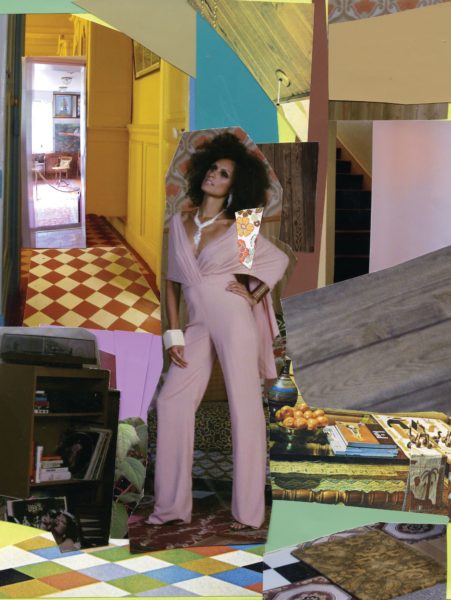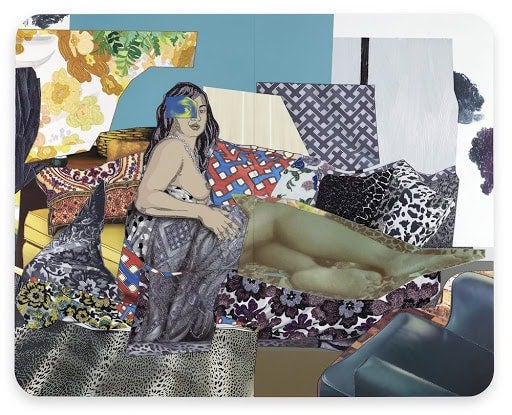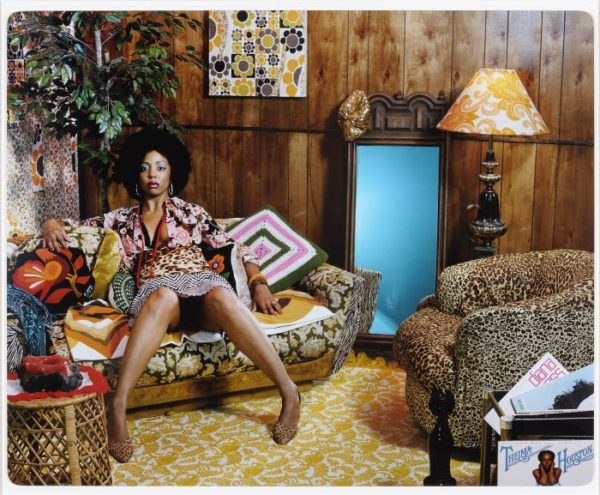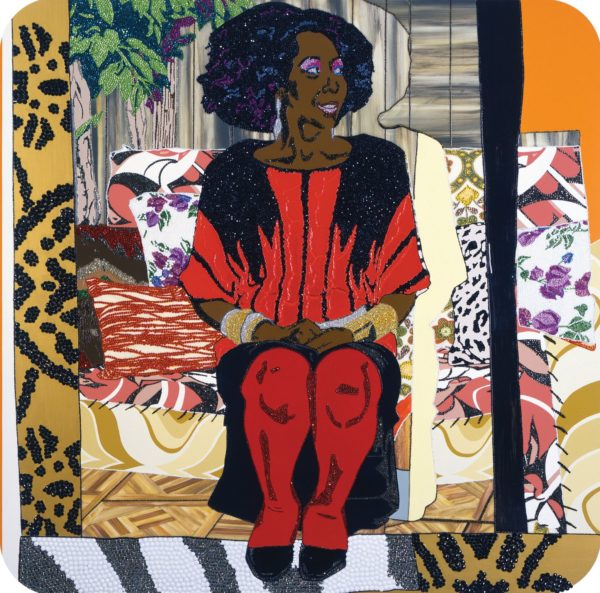
It’s easy to love the rhinestone-encrusted work of New York artist Mickalene Thomas and the temerity of an artist who would dare to bedazzle paintings that otherwise quote from the canon of the male gaze. Her large-scale mixed media images, on view through April 9 in the Newcomb Art Museum’s exhibition “Mickalene Thomas: Waiting on a Prime-Time Star,” tend to present strong and confident women of color, often posed to recall the composition of paintings like Manet’s Olympia, in which the whiteness of Olympia’s body clearly contrasts with the dark skin of the servant figure behind her. Thomas subverts long-held Western assumptions that white bodies define beauty; Thomas’s figures insist, instead, that “Black is beautiful.” The 1970s slogan is an apt reference, as her models resemble Blaxploitation film heroines—like the afro in matte rhinestones that dominates the composition of Did I hear you say you love me (2006). The half-dressed figure sits on a couch covered in red and blue weave pattern made of rhinestones, which evokes the power of the male gaze by making the viewer want to reach out and touch — a desire so strong that the museum affixed a cautionary label next to each painting that requests “Please do not touch the art.”

The Newcomb show brings together a variety of mediums to show how Thomas’s work progresses from collage to set to photograph to painting to print. Racquel wearing a purple jumpsuit (2016), for instance, appears as both a preparatory collage and a big rhinestone-bedazzled painting. In both, the figure leans back on a couch, her head playfully tossed back. Her pose recalls Manet’s Olympia, which itself quoted from Renaissance paintings of a reclining Venus, such as Titian’s Venus of Urbino. The painting, done in rhinestones, glitter, flock, acrylic and oil on wood panel, mimics collage by depicting the figure in part with thick patches of paint, and in part with photographic pieces. One leg is placed firmly on the ground, and our attention is drawn to that foot’s blingy stiletto placed on of an impasto swirl of Pepto pink paint. In the collage version, the stilettos are snakeskin and resting on patches of carpet.

Racquel’s reclining pose is repeated, with variation, in Shinique: Now I Know (2015) and Tamika sur une chaise longue avec Monet (2012). Tamika’s is an image that evokes luxury and relaxation, and yet the patterns also feel claustrophobic. Her clothes and the textiles recall Orientalist paintings of the odalisque, specifically those by Matisse in his obsession with patterns and prints. And yet the painting also recalls Miriam Schapiro’s concept of femmage, a term that combines feminism and collage. The Pattern & Decoration movement, which Schapiro was involved in, also gave us Valerie Jaudon and Joyce Kozloff’s article about “art hysterical notions of progress and culture,” a portion of which questioned the feminization of the “decorative” in Matisse’s work.
In Sleep: Deux femmes noires (2013), we see how Thomas uses a combination of woodblock, screen print, and digital methods to make large-scale prints. This one is based on Courbet’s 1886 painting Le Sommeil (Sleep), in which two nude female figures are sleeping on a bed, twisted around each other in an erotic embrace. This print, the third iteration of her take on the Courbet image, recreates the Courbet composition but with black bodies instead of white.

Can Thomas’s redo of Courbet cancel out its titillating use of lesbianism for a male gaze, and instead say something about queer desire today? The photograph Lovely Six Foota (2007) is more successful in that respect. This afro-wearing woman is sitting on a couch, leaning back provocatively with one arm draped over the back of the sofa. Her skirt doesn’t cover her knees, and her legs are spread to reveal a dark area of shadow in between. Our eyes go there immediately. It is a Basic Instinct moment. Lovely Six Foota, a name that Thomas explained was the model’s own choice, is staring straight at us, lips closed in silence, and her eyes seem to say that she knows that she is daring us to look into what Courbet called “the origin of the world.” She obviously exudes sexuality, for both a male and female gaze, that threatens to engulf us.

The show claims to focus on the theme of portraiture, and while much of the strength of Thomas’s work comes from the figure, we do not get to know their personalities in any real sense. There is one crucial exception, and that is the work about Thomas’s mother, Sandra Bush, who passed away in 2012. She is present throughout the exhibition: first as a relic, with her clothing cast in bronze and hung on hangers in the gallery’s first room, then as an icon. She stands tall in the large-scale photo Mama Bush: (Your love keeps lifting me) Higher and Higher (2012) wearing a striking black suit with leopard print lapels. She leans back a little, her mouth open and her eyes almost closed, as if she is laughing. Her hair is big—in a good way—and the lights reflect off her red lipstick. A bedazzled version of the same laughing face appears in Sandra: She’s a Beauty (2009), in which rhinestones delineate her knees, shadows, and bracelets.
TRAILER: “Happy Birthday to a Beautiful Woman” A film by Mickalene Thomas from TheStarkLife on Vimeo.
The depictions of Mama Bush are all about elegance and strength, but the 2012 video Happy Birthday to a Beautiful Woman lets us see behind her facade. Set off from the gallery by three walls covered in faux wood paneling, the video plays in a staged living room set. Titled Waiting on a Prime-Time Star (2016), the installation features a couch covered in a riot of prints, a pair of gold shoes on the floor, and kitschy decorations — a bouquet of plastic flowers, a fake tree set in a mirror-paneled corner, a basket of spray-painted gold fake fruit on the battered coffee table. The space feels like a memory of a family room from the 1970s, filled with photo albums and a carefully curated selection of books that reads like a who’s who of African-American literature: Alice Walker, Zadie Smith, Octavia Butler, Chimamanda Ngozi Adichie, Angela Davis, James Baldwin, Toni Morrison, and Maya Angelou.
The jubilant feeling of the colors and prints used in the space is countered by the darker stories told by her mother in the video. She talks about getting pregnant, then losing the baby but getting married anyway to an abusive man who raped her at gunpoint. Later, while she’s in the hospital, she talks about surviving drug addiction. Thomas asks hard questions, like “Do you think about dying?” But she also finds an enjoyable nostalgia in her mother’s memories of growing up in Camden New Jersey, singing in the church choir, and falling in love with the Marvelettes song “Don’t Mess with Bill.” In the film, we get to really explore her personality and appreciate how her mother’s poise and beauty have been hard won. We come to admire her strength in the face of adversity, her commitment to pressing on.
The show’s theme is said to be inspired by Robert Colescott’s painting Colored TV (1977), but the better reference comes from the film when Bush remarks, “If I could, I’d be a star.” Her voice tinged with regret, she explains that she could have had a big modeling career. Thomas’s artworks illustrate that dream of becoming a “prime-time star.” In Thomas’s glitzy world, women do get to be stars. It is sad when we only get to be stars in our fantasies, but this tension between fantasy and reality is what drives Thomas’s work, and what makes the work about her mother particularly successful.
“Mickalene Thomas: Waiting on a Prime-Time Star” is on view at Newcomb Art Museum through April 9.
Rebecca Lee Reynolds is an assistant professor in the department of fine arts at the University of New Orleans, where she teaches art history.




